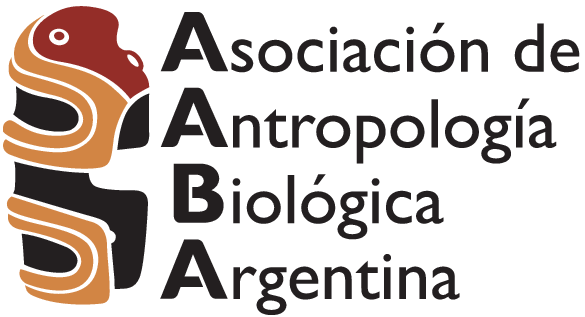El error de observación y su influencia en los Análisis morfológicos de restos óseos humanos. Datos de variación continua
Abstract
RESUMEN: La utilizaci6n de métodos rnorfométricos se constituy6 a lo largo del siglo XX en una de las aproxirnaciones más ernpleadas en el carnpo de la antropología biológica. Junto con el gran desarrollo alcanzado por la rnisma se generalizó el ernpleo de bases de datos generadas por otros investigadores con fines cornparativos. Por este motivo se ha hecho necesario elaborar estrategias metodol6gicas que permitan evaluar e incrementar la precisi6n en las observaciones tomadas por uno o rn6s observadores. El objetivo de este trabajo es evaluar el error intra e interobservador en el relevarniento de variables métricas craneofaciales y la influencia de estos en el análisis de relaciones biológicas poblacionales. Con esta finalidad se elabor6 un diseño experimental de bloques completos aleatorios con medidas repetidas. Se analizó una muestra de 20 cráneos procedentes del Valle de Rio Negro - 10 con deformaci6n pseudocircular y 10 con deformación planolámbdica-. Cuatro observadores registraron un conjunto de ocho variables métricas craneofaciales. Las observaciones fueron comparadas mediante pruebas estadísticas de correlación intraclase y ANOVA de medidas repetidas. A su vez, se efectuaron análisis multivariados con el fin de conocer las relaciones entre las muestras de cráneos deformados medidas por los diferentes observadores. Los resultados obtenidos indican que hubo un incremento en la consistencia de las observaciones efectuadas por cada observador, que el error interobservador fue mayor entre los observadores no entrenados y que las inconsistencias en las observaciones afectaron los resultados obtenidos en los análisis multivariados tendientes a conocer las relaciones entre las muestras. Rev. Arg. Antrop. Biol. 6(1): 61-75, 2004
ABSTRACT: The application of morphometric methods became one of the most frequently used approaches in the field of Biological Anthropology throughout the 20th century. Concurrently with this development, the use of databases generated by different researchers became widespread in comparative studies. Therefore, it has become necessary to develop methodological strategies that allow an evaluation of the observations made by one or more observers and increase their accuracy. The aim of this paper is to evaluate the intra- and interobserver error in the scoring of craniofacial metric variables and its influence on the analysis of biological relationships between populations. For this purpose, an experimental design of random complete blocks with repetitions was applied. A sample of 20 skulls from Rio Negro Valley - 10 with pseudo-circular deformation and 10 with plane-lambdic deformation- was analyzed. Four observers recorded a set of eight craniofacial metric variables. The observations were statistically compared by means of intra class correlation tests and repeated measures ANOVA. Multivariate analyses were also performed to assess the relationships among the samples of deformed skulls measured by different observers. Our results indicate an increase in the consistency of the observations made by each observer, higher inter-observer error values among non-trained observers, and the influence of the inconsistencies among observations on the results of the multivariate analyses designed for the assessment of inter-sample relationships. Rev. Arg. Antrop. Biol. 6(1): 6 1-75. 2004.
Downloads
Metrics
References
Barrientos G y Perez SI (2004) Was there a population replacement during the late middle Holocene in the southeastern Pampas of Argentina? Discussing its archaeological evidence and its paleoecological basis. En Zarate M, Neme G y A Gil (eds): Quaternary International (Special Volume) Ocupaciones Humanas Durante el Holoceno Medio en el Extremo Sudamericano. INQUA, Pergamon Press. En prensa.
Bernal V, Gonzalez P, Perez I y Del Papa M (2004) Evaluaci6n del error intraobservador en bioarqueologia. Intersecciones en Antropologia 5: 129-140.
Blackith RE y Reyment RA (1971) Multivariate Morphometrics. London, Academia London Press.
Buikstra JE, Frankenberg SR y Konigsberg LW (1990) Skeletal biological studies in American physical anthropology: recent trends. Am. J. Phys. Anthropol. 82: 1-7.
Cochran WG y Cox GM (1 997) Diseiios Experimentales. MCxico, Editorial Trillas.
GuichÓn R, Frascaroli F y Muiioz S (1996) Disefios de experimentos para el estudio de la variaci6n interobservador: una aplicaci6n en antropologia biol6gica. Arqueologia: Solo Patagonia. Ponencias de las I1 Jornadas de Arqueologia de la Patagonia, pp.207-2 13.
GuichÓn R, Neder S y Orellana L (1993) Algunas consideraciones sobre 10s disefios de experimentos y estudios observacionales en antropologia biol6gica. Palimpsesto. Revista de Arqueologia 3:53-61.
Howells WW (1 973) Cranial variation in man. A study by multivariate analysis of patterns of difference among recent human populations. Papers of Peabody Museum of Archaeology and Ethnology Harvard University Vol. 67. Cambridge, Mass.
Howells WW (1 996) Howell's craniometric data on the Internet. Am. J. Phys. Anthropol. 101:441-442.
Jamison P y Zegura SL (1974) A univariate and multivariate examination of measurement error in anthropometry. Am. J. Phys. Anthropol. 40: 197-204.
Jantz E y Owsley D (2002) Variation among early North American crania. Am. J. Phys. Anthropol. 1 14: 146 - 155.
Kruskal JB (1 964a) Multidimensional scaling by optimizing goodness of fit to a nonmetric hypothesis. Psychometrics 29: 1-27.
Kruskal JB (1 964b) Nonmetric multidimensional scaling: a numerical method. Psychometrics 29: 11 5-1 29.
Mahalanobis PC (1925) Analysis of race mixture in Bengal. J. Asiatic Soc. Bengal23:301-333.
Mahalanobis PC (1930) On test and measures of group divergence. J. Asiatic Soc. Bengal26541-588.
Mahalanobis PC (1936) On the generalizated distance in statistics. Proc. Nat. Inst. Sci. India 2:49-55
Manly BFJ (1994) Multivariate Statistical Methods. Ed. Chapman & Hall.
Mantel N (1967) The detection of disease clustering and a generalizated regression approach. Cancer Research 27:209-220.
Marcus LF (1990) Traditional morphometrics. En Rohlf FJ y Bookstein FL (eds): Proceedings of the Michigan Morphometrics Workshop. Special Publication Number 2. Ann Arbor, University of Michigan. Museum of Zoology, pp.77-122.
Rohlf F y Marcus L (1993) A revolution in morphometrics. Tree 8:129-132.
Saunders SR (1989) Nonmetric skeletal variation. En Iscan MY y Kennedy KAR (eds): Reconstruction of Life from the Skeleton. New York, Alan R Liss, Inc.,pp.95-108.
Segobit Software (2001 ) Programa Random Number Generator Pro V1.26. http//:www.segobit.com
Smouse PE y Long JC (1992) Matrix correlation analysis in anthropology and genetics. Am. J. Phys. Anthropol. 35: 187-213.
Utermohle CJ y Zegura SL (1982) Intra and interobserver error in craniometry: A cautionary tale. Am. J. Phys. Anthropol. 57:303-310.
Waddle DM (1994) Matrix correlation test support a single origin for modem humans. Nature 368:452-454.
Yezerinac SM, Lougheed S y Handford P (1992) Measurement error and morphometric studies: statistical power and observer experience. Syst. Biol. 41 :47 1 - 482.
Zar JH (1 999) Biostatistical Analysis. New Yorkj Prentice Hall.
Downloads
Published
How to Cite
Issue
Section
License
The RAAB is a diamond-type open access journal. There are no charges for reading, sending or processing the work. Likewise, authors maintain copyright on their works as well as publication rights without restrictions.























